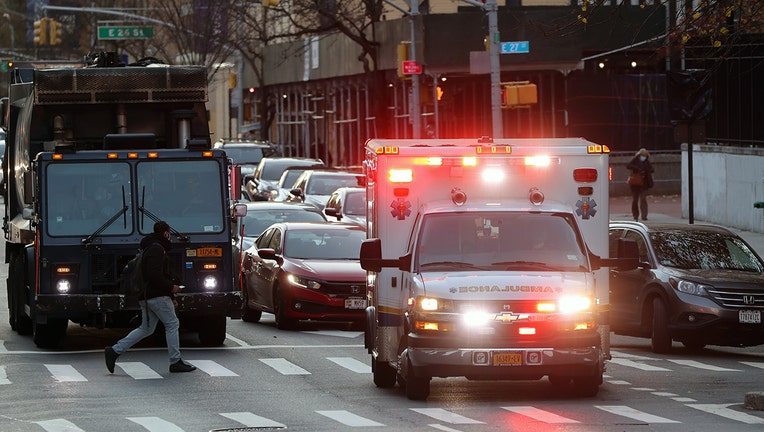Emergency services at ‘breaking point’ amid COVID-19 pandemic, ambulance group warns HHS

An ambulance drives through the streets of Manhattan on December 02, 2020 in New York City. New York City, and much of the nation, is bracing for a surge of COVID-19 cases following the Thanksgiving holiday which saw millions of Americans travel to s
LOS ANGELES - The American Ambulance Association warned the U.S. Department of Health and Human Services that emergency services are at a “breaking point” due to the added burden created by the ongoing COVID-19 pandemic.
Aarron Reinert, president of the AAA, asked in a letter that additional funding be funneled to emergency services to help maintain the basic services emergency personnel provided even before the pandemic.
“Given the substantially heavier burden that AAA members are carrying during the pandemic, we reiterate our request for HHS to provide additional funding from the Congressionally allocated dollars for the Provider Relief Fund specifically to ground ambulance service providers to ensure the stability of these essential providers and suppliers as the country continues to battle the pandemic,” Reinert wrote.
RELATED: Pennsylvania sets daily high with over 11,700 new COVID-19 infections
The association asked that monies be allocated “specifically to ground ambulance service providers to ensure the stability of these essential providers and suppliers as the country continues to battle the pandemic.”According to Reinert, calls for emergency medical services have exploded in volume during the pandemic.
“For example, in hot spot areas, such as New Rochelle, New York, 9-1-1 medical responses that did not result in an ambulance transport increased from 500 to 6,049 during the public health emergency compared to the same timeframe last year. Their mandatory treatment in place without transport reduced their transport volume by 25 percent,” Reinert said.
The group’s request comes as hospitalizations in the U.S. hit an all-time high due to surging COVID-19 cases.
With the virus surging from coast to coast, the number of patients in the hospital with the virus has more than doubled over the past month to a record high of nearly 100,000, pushing medical centers and health care workers to the breaking point. Nurses are increasingly burned out and getting sick on the job, and the stress on the nation's medical system prompted a dire warning from the head of the U.S. Centers for Disease Control and Prevention.
“The reality is December and January and February are going to be rough times. I actually believe they are going to be the most difficult time in the public health history of this nation,” Dr. Robert Redfield said.
RELATED: Beloved Charlie Brown Christmas celebration goes on despite pandemic
“The overall weekly hospitalization rate is at its highest point in the pandemic, with steep increases in individuals aged 65 years and older,” according to a report from the CDC. "The overall cumulative COVID-19-associated hospitalization rate through the week ending November 21, 2020, was 243.8 hospitalizations per 100,000 population.
"Reinert asked that $2.62 billion be allocated to emergency services, which would equal to about $43,500 per ambulance, as opposed to the $350 million that was originally given by the Provider Relief Fund, a fund established under the CARES Act to support American families, workers and health care providers in response to the pandemic.
HHS wrote that it plans to distribute $175 billion to hospitals and health care providers on the front lines of the coronavirus response from the fund.
Skilled nursing facilities, which includes nursing homes, received $7.4 billion from the relief fund, rural hospitals received $11 billion, and safety net hospital received $14.4 billion, according to data from the CARES Act Provider Relief Fund.
“Private ground ambulance services, which operate 28% of all emergency services nationwide as cited by the GAO, have received nearly zero funding from FEMA, SAFER (Staffing for Adequate Fire and Emergency Response) grants, and State and local funds to address increasing PPE and other costs related to the pandemic,” Reinert added.
RELATED: California calls for temporary halt on non-essential travel during virus surge
“As you can see from these data points, there has been an increased burden on ground ambulance suppliers that few other providers have experienced. Without ground ambulance services, communities across the country would not be able to fight the pandemic,” Reinert wrote.
Meanwhile, states drafted plans Thursday for who will go to the front of the line when the first doses of COVID-19 vaccine likely become available later this month, as U.S. deaths from the outbreak eclipsed 3,100 in a single day, obliterating the record set last spring.
With initial supplies of the vaccine certain to be limited, governors and other state officials are weighing both health and economic concerns in deciding the order in which the shots will be dispensed.
The Associated Press contributed to this report.

